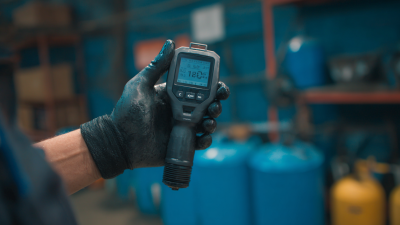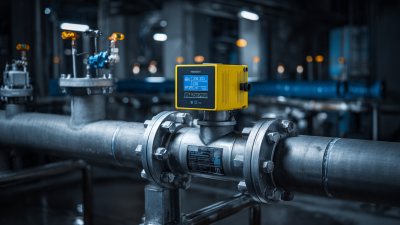How to Effectively Measure Water Flow Using Ultrasonic Technology
In recent years, the demand for accurate water flow measurement has surged, driven by the need for efficient resource management and environmental sustainability. Ultrasonic technology has emerged as a leading solution, specifically through the use of the Ultrasonic Water Flow Meter, which offers non-invasive and highly precise flow measurement capabilities. According to a report by Markets and Markets, the global ultrasonic flow meter market is projected to grow from $1.29 billion in 2020 to $1.70 billion by 2025, highlighting the increasing adoption of this technology across various industries. Its advantages, such as low maintenance costs, minimal pressure loss, and the ability to measure variable flow rates, make the Ultrasonic Water Flow Meter an ideal choice for municipal water systems, industrial applications, and energy management. This guide will delve into effective methodologies for measuring water flow using ultrasonic technology, ensuring accurate data collection and informed decision-making.

Understanding the Basics of Ultrasonic Flow Measurement Technology
Ultrasonic flow measurement technology relies on the principle of sound wave propagation through a fluid to determine its flow rate. By emitting ultrasonic pulses from a transducer, these waves travel through the liquid and reflect back to the sender. The time it takes for the sound waves to return is a crucial parameter, as it varies depending on the flow velocity of the fluid. This method is highly effective in providing accurate and real-time data on flow rates across a variety of applications, including water management, industrial processes, and HVAC systems.
Understanding the basics of this technology involves grasping the two main categories of ultrasonic flow meters: transit-time and doppler. Transit-time flow meters measure the difference in travel time of ultrasonic signals sent upstream and downstream, effectively calculating the velocity of the fluid. On the other hand, Doppler flow meters utilize the frequency shift of the reflected sound waves from particles or bubbles in the flowing liquid to determine flow velocity. Each method has its specific applications, making it essential to choose the right technology based on the characteristics of the fluid and the installation environment.
Key Components of Ultrasonic Flow Measurement Systems
Ultrasonic flow measurement systems have gained significant traction in various industries due to their accuracy and non-intrusive nature. One of the key components of these systems is the transducer, which emits and receives ultrasonic waves to determine the flow rate of liquids and gases. According to a report by MarketsandMarkets, the ultrasonic flow meter market is expected to reach $3.1 billion by 2025, highlighting the growing reliance on this technology for precise measurement.

Another crucial element of ultrasonic flow measurement systems is the signal processing unit. This component interprets the data received from the transducers and converts it into meaningful flow rate information. Advanced algorithms and digital processing techniques are essential for enhancing measurement accuracy and compensating for factors such as temperature and pressure changes. A study published in the Journal of Flow Measurement and Instrumentation indicates that ultrasonic flow meters can achieve accuracies of up to 1% of the reading, making them suitable for critical applications in industries such as oil and gas, water management, and pharmaceuticals.
The overall reliability of ultrasonic flow measurement systems also depends on the calibration process. Proper calibration ensures that the system maintains accuracy over time, which is vital for compliance with regulatory standards in various sectors. International standards such as ISO 5167 emphasize the importance of regular calibration and validation to uphold measurement integrity, further solidifying the role of ultrasonic technology in effective flow measurement.
Step-by-Step Guide to Installing Ultrasonic Flow Meters
Installing ultrasonic flow meters requires careful planning and execution to ensure accurate water flow measurement. To begin, select the appropriate ultrasonic flow meter for your specific application. Factors such as pipe size, medium (liquid or gas), and installation location must be considered. Begin with a clean and accessible section of the pipe, ensuring that any nearby valves or fittings do not introduce turbulence that could affect the readings.
The installation process typically involves attaching the flow meter to the exterior of the pipe. For clamp-on models, this means using appropriate mounting brackets and alignment tools to secure the device. Make sure the transducers are placed diametrically opposite each other to optimize signal transmission. After mounting, connect the device to a power source and configure it according to the manufacturer's specifications. Calibration may be necessary to account for specific fluid characteristics to ensure measurements are both reliable and precise.
Once installed, it's crucial to regularly monitor the flow meter's performance. Routine maintenance checks can help identify any drift in readings or potential servicing issues, particularly in applications involving buried or submerged pipes. By following these steps, professionals can effectively harness ultrasonic technology for efficient water management, paving the way for improved operational performance in various industries.
Ultrasonic Flow Meters Data Analysis
This chart displays the water flow rates measured by ultrasonic flow meters over a specific time period, showcasing the effectiveness and reliability of this technology.
Best Practices for Calibrating Ultrasonic Flow Measurement Devices
Calibration is a crucial step in ensuring the accuracy and reliability of ultrasonic flow measurement devices. Best practices for calibration include employing standard flow meters, gravimetric methods, and volumetric techniques to benchmark flow rates effectively. Recent studies in flow rate calibration for instruments used in high-performance liquid chromatography (HPLC) illustrate that standard flow meters can provide reliable data under controlled conditions, ensuring consistent performance in various applications.
As the flow management systems market is projected to reach USD 30.9 billion by 2035, enhancements in calibration technologies are vital for meeting the growing demand for precision. This forecast aligns with the increasing interest in noninvasive measurement methods, highlighting the need for continuous improvement in device accuracy. In particular, using multiple sensors can significantly enhance measurement reliability, especially in critical industrial applications. Therefore, implementing rigorous calibration protocols will support developments in ultrasonic technology and fulfill the standards required for modern flow management systems.

Troubleshooting Common Issues in Ultrasonic Water Flow Measurement
When measuring water flow using ultrasonic technology, operators may encounter common issues that can hinder accurate readings. One prevalent problem is improper installation of the ultrasonic sensors. If the sensors are misaligned or not positioned correctly on the pipe, it can lead to erroneous measurements. Therefore, it’s crucial to follow the manufacturer's guidelines closely during installation.
**Tips:** Ensure the transducers are mounted on clean, dry surfaces free from any obstructions. Verify that they are positioned according to the required angle and alignment specifications for optimal performance.
Another common issue is signal interference, which can distort the ultrasonic waves used for flow measurement. Environmental factors, such as vibrations from nearby equipment or temperature fluctuations, can impact the accuracy of the readings. Regular maintenance and periodic checks can help mitigate these effects.
**Tips:** Utilize shielded cables and position the sensor away from potential sources of vibration. Implementing a routine calibration schedule can further ensure that the system consistently provides reliable data.
Related Posts
-

7 Essential Flow Meter Types Every Industry Should Know
-

Innovative Solutions for Inline Water Meter Efficiency Optimization
-

How to Choose the Right Mag Meter for Your Industrial Applications
-

7 Best Flow Meter Types for Accurate Measurement in 2023
-

Exploring the Various Alternative Technologies for Non Contact Flow Meters
-

Understanding the Mechanisms Behind Turbine Flow Meters
